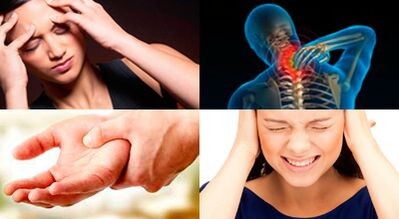The symptoms of cervical osteochondrosis are so contradictory that in the early stages of the disease it is often misdiagnosed and a completely different disease is treated. But over time, clearer signs appear and it becomes clear that the cause of the ailments is damage to the spine. Cervical spondylosis is insidious due to its gradual development, so many patients for a long time do not even suspect that they are at risk for a long time.
The disease can be caused by congenital or acquired injuries, heredity, physical overload, poor posture and excess weight. Each case has its own individual cause for the creation of this disease.
Developmental stages of cervical osteochondrosis

The symptoms of cervical osteochondrosis depend on the stage at which the patient is. At each stage of spondylosis they manifest differently. There are four stages in total.
- First stage. There is initial destruction and loss of elasticity of the intervertebral discs. It can be accompanied by neck pain, but sometimes there is only temporary discomfort, which few people pay attention to.
- Second level. The intervertebral spaces are reduced and the annulus fibrosus is destroyed. The severe pain becomes constant due to the pinched nerve root. The manifestations of the disease become intense, and the treatment of the symptoms of cervical osteochondrosis usually begins at this stage. It is necessary to start doing exercises for cervical osteochondrosis.
- Third stage. Complete destruction of the annulus fibrosus is observed. Intervertebral hernias and significant spinal deformity occur. Migraines, nausea, dizziness and numbness of the extremities are often observed.
- Fourth stage. The symptoms of osteochondrosis of the cervical spine become advanced and manifest as sharp attacks of pain with any movement. Bony growths form, limiting movement.
The main symptoms of cervical osteochondrosis
The symptoms of osteochondrosis of the cervical spine and their treatment will largely depend on the stage and neglect of spondylosis and the state of health of the patient; at all stages they are completely different.
The most characteristic manifestations of osteochondrosis in the cervical spine are:
- severe headaches at the back of the head, at the temples, at the crown of the head.
- dizziness, fainting;
- severe pain radiating to arms and shoulders;
- impaired coordination and vision.
- throbbing pain in brow ridges, temples.
- change in tone of voice, hoarseness, snoring.
- painful affections radiating to chest;
- heart pain resembling angina pectoris;
- aching toothache;
- numbness of the face, fingers;
- breathing problems, nausea, eye and heart pain.
- memory impairment and reduced intelligence.
- pain in the neck, forearm, hand.
- tinnitus;
- tingling of the extremities, weakness, chills.
Main syndromes of cervical spondylosis
Cervical osteochondrosis can appear in different forms in different patients. Doctors have combined such symptoms into clinical syndromes.
Cardiac syndrome
It has symptoms similar to angina. Because of this similarity, there is a serious risk of failure to treat cardiac ischemia instead of cervical spondylosis. It is characterized by irritation of the nerve roots of the thoracic region or the phrenic nerve. This syndrome is accompanied by prolonged paroxysmal pain. Tachycardia and extrasystole are observed. But the cardiogram shows no abnormalities.
Irritable-reflex syndrome
It is always accompanied by burning, unbearable pain in the neck-occipital region, especially sharp during movement. The symptoms of cervical osteochondrosis, manifested in this syndrome, consist of severe pain in the shoulder and chest.
Radical syndrome
More commonly known as cervical sciatica. It occurs when the nerve endings of the cervical spine are compressed. When nerve root compression occurs, the pain threshold descends from the neck to the shoulder blades, moving to the shoulder, forearm and fingers. Possible fermentation, tingling, goosebumps.
Vertebral artery syndrome
The patient begins to suffer from a burning, throbbing headache in the region of the browbones, crown of the head, back of the head, and temples; it may be constant or paroxysmal. If the immune system is weakened, dizziness, nausea and possible fainting occur. Hearing acuity decreases, noise is heard in the ears and the function of the vestibular apparatus is disturbed. Sometimes there is a significant decrease in vision.
Cervical spondylosis
The symptoms of cervical osteochondrosis are very similar to cervical spondylosis. But the peculiarity of this complication is that it is often misdiagnosed. It is usually confused with angina pectoris or vegetative-vascular dystonia. Unfortunately, many patients have to take useless drugs until it is proven that the cause of serious diseases is thoracic osteochondrosis.
It is characterized by painful attacks similar to intercostal neuralgia, cardiac ischemia or cholecystitis or gastritis. Body movements are very difficult, the patient is afraid to breathe deeply.
Symptoms of cervical osteochondrosis
The symptoms of cervical osteochondrosis also have their own characteristics, the treatment of which differs little from the general principles of treatment of this disease. The main manifestations of this pathology:
- Asthenic syndrome;
- migraine attacks;
- blood pressure jump;
- lack of coordination;
- double vision or stars in the eyes.
- dizziness;
- pain in the neck, chest, heart.
- numbness and coldness in the fingers.
- pain in arms, shoulders, along sides;
- constant noise in the ears.
Many patients believe that the manifestation of the disease consists only of constant pain, but this is not so. Dangerous complications can occur that lead to disability. Advanced osteochondrosis leads to protrusion of the cervical spine, hernias, intercostal neuralgia, radiculitis and complete deformity of the fingers.
Therefore, if you periodically feel pains of various types or the symptoms listed above are familiar to you, immediately seek professional help.


























